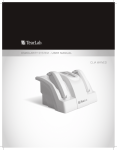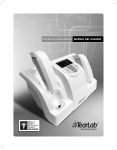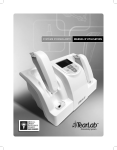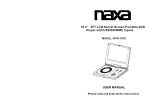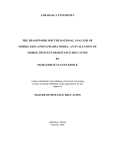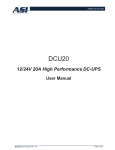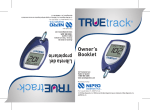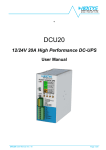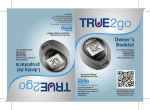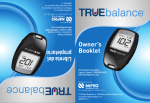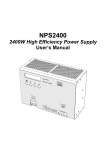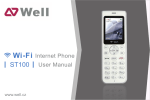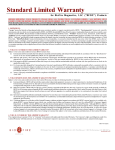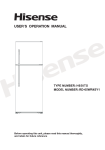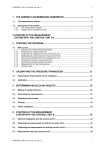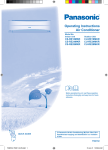Download 92321 TearLab_UserMan_Eng.indd
Transcript
OSMOLARITY SYSTEM
USER MANUAL
OSMOLARITY SYSTEM
CONTENTS
IN C LUD E D CON TEN T:
TEARLAB READER
PEN
ELECTRONIC
CHECK CARDS
TearLab Reader
(2) TearLab individually boxed Pens with magnetic cardboard sleeves, Instructions for Use, and a set of adhesive
identification labels
Set of (2) Electronic Check Cards with Instructions for Use
TearLab User Manual
TearLab Quick Reference Guides
Power Supply
Power Cord(s)
S OL D S E PAR ATELY:
OSMOLARITY
TEST CARDS
OSMOLARITY
CONTROL SOLUTIONS
OSMOLARITY SYSTEM
TA B L E O F CO N T E N T S
PRODUCT OVERVIEW. . . . . . . . . . . . . . . . . . . . . . . . . . . . . . . . . . . 1
PERFORMANCE CHARACTERISTICS . . . . . . . . . . . . . . . . . . . . . . 7
PRINCIPLES OF THE PROCEDURE . . . . . . . . . . . . . . . . . . . . . . . . 1
Result Interpretation . . . . . . . . . . . . . . . . . . . . . . . . . . . . . . . . . . . . . . . . 7
SYSTEM COMPONENTS . . . . . . . . . . . . . . . . . . . . . . . . . . . . . . . . . 1
Expected Results . . . . . . . . . . . . . . . . . . . . . . . . . . . . . . . . . . . . . . . . . . . 7
INSTALLATION . . . . . . . . . . . . . . . . . . . . . . . . . . . . . . . . . . . . . . . . . 2
SPECIFICATIONS . . . . . . . . . . . . . . . . . . . . . . . . . . . . . . . . . . . . . . . 8
TEARLAB PENS . . . . . . . . . . . . . . . . . . . . . . . . . . . . . . . . . . . . . . . . . 3
HAZARDS . . . . . . . . . . . . . . . . . . . . . . . . . . . . . . . . . . . . . . . . . . . . . 8
QUALITY CONTROL . . . . . . . . . . . . . . . . . . . . . . . . . . . . . . . . . . . . 4
OPERATIONAL PRECAUTIONS . . . . . . . . . . . . . . . . . . . . . . . . . . . 8
Calibration . . . . . . . . . . . . . . . . . . . . . . . . . . . . . . . . . . . . . . . . . . . . . . . . . . 4
MAINTENANCE . . . . . . . . . . . . . . . . . . . . . . . . . . . . . . . . . . . . . . . . 9
Electronic Check Card . . . . . . . . . . . . . . . . . . . . . . . . . . . . . . . . . . . . . . 4
TECHNICAL SERVICE . . . . . . . . . . . . . . . . . . . . . . . . . . . . . . . . . . . 9
Control Solutions . . . . . . . . . . . . . . . . . . . . . . . . . . . . . . . . . . . . . . . . . . . 5
REPLACEMENT PARTS . . . . . . . . . . . . . . . . . . . . . . . . . . . . . . . . . . 9
Sample Material. . . . . . . . . . . . . . . . . . . . . . . . . . . . . . . . . . . . . . . . . . . . . 5
TROUBLESHOOTING . . . . . . . . . . . . . . . . . . . . . . . . . . . . . . . . . . 10
HOW TO PERFORM AN OSMOLARITY TEST. . . . . . . . . . . . . . . . . . . . . 5
WARRANTY . . . . . . . . . . . . . . . . . . . . . . . . . . . . . . . . . . . . . . . . . . . 12
Tear Collection Procedure . . . . . . . . . . . . . . . . . . . . . . . . . . . . . . . . . . 6
EMC AND SAFETY . . . . . . . . . . . . . . . . . . . . . . . . . . . . . . . . . . . . . 12
Testing Osmolarity Controls . . . . . . . . . . . . . . . . . . . . . . . . . . . . . . . . 7
REFERENCES . . . . . . . . . . . . . . . . . . . . . . . . . . . . . . . . . . . . . . . . . . 14
OSMOLARITY SYSTEM
PRODUCT OVERVIEW
The TearLab Osmolarity System is a tear fluid collection and testing device for the quantitative measurement of osmolarity (concentration of
dissolved, active particles in solution) of human tears in normal and Dry Eye Disease patients. TearLab is for professional in vitro diagnostic use only.
Tears fulfill an essential role in maintaining ocular surface integrity, protecting against microbial challenge, and preserving visual acuity. These
functions, in turn, are critically dependent upon the composition and stability of the tear film structure. Disruption, deficiency, or absence of the
tear film can severely impact the eye. Associated disorders can lead to desiccation of the corneal epithelium, ulceration and perforation of the
cornea, an increased incidence of infectious disease, and other clinical conditions.1
Hyperosmolarity has been described in the literature as a primary marker of tear film integrity.2 When either the quantity or quality of secreted
tears is compromised (known as aqueous deficient or evaporative Dry Eye Disease), increased rates of evaporation lead to a concentrated tear film
(increased osmolarity) that places stress on the corneal epithelium and conjunctiva.
The TearLab Osmolarity Test Card, in conjunction with the TearLab Osmolarity System, provides a quick and simple method for determining tear
osmolarity using nanoliter (nL) volumes of tear fluid collected directly from the eyelid margin. To perform a test, attach a new Test Card onto the
Pen and touch the tip of the Pen to the tear fluid meniscus located above the lower eyelid. After a successful collection, dock the Pen into the
Reader, which will display a quantitative tear osmolarity test result on the liquid crystal display (LCD). The TearLab Osmolarity System simplifies the
tear-collection process by eliminating the need to transfer tear fluid samples and reducing the risk of evaporation.
P R INC IP LES OF TH E PROCED UR E
The TearLab Osmolarity Test utilizes a temperature-corrected impedance measurement to provide an indirect assessment of osmolarity.3 After
applying a lot-specific calibration curve, osmolarity is calculated and displayed as a quantitative numerical value.
OSMOLARITY SYSTEM
SYSTEM COMPONENTS
T E A R L A B O S M O L A R I T Y S YS T E M R E A D E R
The Reader is a portable countertop unit that calculates and displays the osmolarity test result. The Reader has an LCD screen, a keypad, and an
external AC power supply. Left and right cradles allow two Pens to dock into the Reader. When Pens are docked, the Reader automatically converts
the tear fluid sample data into an osmolarity measurement and displays the reading on the LCD.
T E A R L A B O S M O L A R I T Y S YS T E M P E N
The Pen is designed to hold the Test Card and facilitate safe, simple tear fluid collection. The Pen electronics confirm the proper attachment of
the Test Card onto the Pen, detect the presence of tear fluid in the Test Card, and signal when a tear fluid sample has been successfully collected.
Powered by a permanent rechargeable battery, the Pen provides a mechanical/electrical interface to convey data to the Reader automatically
when docked. Each TearLab Osmolarity System includes two Pens to allow sequential tear fluid sample collection from multiple patients or from
the left and right eyes of a single patient.
TEARLAB OSMOLARITY TEST CARD
Each Test Card is a single-use, individually packaged, nonsterile, polycarbonate microchip containing (a) microfluidic channel to collect 50
nanoliters (nL) tear fluid by passive capillary action and (b) gold electrodes embedded in the polycarbonate to enable onboard measurement
of tear osmolarity. Test Cards are clinically hygienic and have a protective cover that should be removed only after the Test Card has been
successfully attached onto the Pen and immediately prior to tear collection. Each Test Card is imprinted with a code that must be entered onto
the Reader at time of testing. Designed to work in conjunction with the TearLab Pen, the Test Card does not contain chemicals or reagents, and
collects tear fluid in less than one second. Please note that TearLab Osmolarity Test Cards are not included with the TearLab Osmolarity System
and must be purchased separately.
TEARLAB ELECTRONIC CHECK CARDS
Two identical, blue reusable Electronic Check Cards are provided as a procedural quality control to confirm the function and calibration of the
TearLab Osmolarity System within manufacturer specifications. The Electronic Check Cards can be used simultaneously for quality control testing,
one with each Pen. The Electronic Check Cards can be used to verify the function of the TearLab if it is mishandled or the Pens are dropped. Tear
fluid samples cannot be collected with the Electronic Check Cards.
1
T E A R L A B CO N T R O L S O LU T I O N S
TearLab Osmolarity Control Solution is a quality control material used for verifying the quantitative performance of TearLab Osmolarity Test Cards
when used with the TearLab Osmolarity System. Routine use of TearLab Osmolarity Control Solution enables laboratories to monitor day-to-day
test variation, lot-to-lot test kit performance and to assist in operator training. These controls can also be used to troubleshoot
invalid results and to identify increases in random or systemic error.
OSMOLARITY SYSTEM
I N S TA L L AT I O N
A Reader, two Pens, a power supply, power cord, and Electronic Check Cards are delivered together with a User Manual and Quick Reference
Guides. Open the carton on a stable surface, remove the components, and set them on a flat surface with at least two inches of space around
the Reader. The Reader and Pens should not be used in direct sunlight and should be at ambient temperature (15-30°C/59-86°F) before use. After
switching the Reader ON, a 25-minute warm-up before use is required. The Reader will indicate when it is ready for use.
1. Each Pen comes with a set of identification labels that can be affixed to the back of the Pen to
distinguish one Pen from the other. Affix labels to the back of each Pen, if desired. Each Pen is also supplied
with a reusable magnetic cardboard sleeve for long-term storage. DO NOT DISCARD. (See “Long-Term Pen
Storage” section on page 3 of this manual.)
2. Insert each Pen into a cradle. The Reader has two cradles to allow simultaneous docking of both Pens.
Either Pen will function in either cradle.
3. Select the power cord that corresponds to your local electrical outlet configuration. Connect the power
cord to the power supply, plug the power cord into an electrical outlet, and connect the power supply to the
back of the Reader. Locate the switch on the back of the Reader and set to the ON
position.
WA R N I N G : Modification of this equipment is not recommended and will nullify the manufacturer’s warranty.
IN ITIAL SE TUP AND M ENU NAVIGATIO N
once to enter the Menu Mode and setup screen.
Upon first use, press the MENU Key
Press the RECALL Key
below the up and down arrows to scroll.
to choose a menu item.
Press the OK Key
to return to the main screen.
Press the MENU Key
to display the previous test result.
When in Test Mode, press the RECALL Key
2
REC ALL KEYS AND TEST M EM O RY
There are two RECALL Keys
previous test result.
corresponding to the left and right cradles. RECALL Keys are used to view the
To recall the previous test result, press and hold the RECALL Key. The previous test result will be displayed on a
dark background to distinguish it from the current test result. Release the RECALL Key and the LCD will revert to
the active screen, displaying the current test result or operation screen. Only the last test result will be held in
memory, and it will remain in memory until the Reader is turned OFF. The RECALL Keys also function as UP and
DOWN when entering the code or navigating the menu.
When turned ON, the Reader LCD will display “Ready,” indicating that testing may be performed. The LCD is split
into left and right sides, corresponding to the left and right docking cradles.
OSMOLARITY SYSTEM
PENS
TEARLAB PENS
Each Pen contains a permanent rechargeable battery. Pens should be docked in the Reader and allowed to
charge for 20 minutes before initial use. The Pen battery automatically recharges when the Pen is docked in the
Reader and the power is switched ON. It is recommended that the Reader power remain ON for continuous Pen
battery charging. A battery icon is located in the left and right corners of the LCD. A flashing battery icon indicates
that the battery is charging. If not flashing, the battery is fully charged. Pen batteries will not overcharge.
WA R N I N G : Only collect tears if the green light is on. NEVER collect tears when the green light is off.
If a Test Card is attached and there is no beep and no green light from the Pen, DO NOT collect tears.
LOW BAT TERY WARNING
When a Pen with low battery power is removed from the Reader, the Reader will emit two informational beeps
and the “BAT LOW” message will appear on the LCD. Do not perform testing. Dock the Pen into the Reader to
charge the battery. When “BAT LOW” changes to “Ready,” the Pen is ready to perform a test.
LON G -TERM PEN STO R AGE Please retain Pen box and Magnetic cardboard
sleeve for long-term storage.
The Pen is packaged with a magnetic cardboard sleeve that automatically turns the Pen OFF when the Pen
is properly inserted. When the magnetic cardboard sleeve is removed, the Pen automatically turns ON. The
Pen will remain ON indefinitely, in either Wake or Sleep Mode. If the Pen is not used for 30 days or more, it is
recommended to store the Pen in the magnetic cardboard sleeve and in its original box to turn the Pen OFF
and to conserve the life of the battery. Failure to store the Pen properly may result in a battery that is completely
discharged beyond its ability to recharge.
Pen batteries are permanent and cannot be exchanged or replaced. Battery failure requires replacement of the Pen.
The Pen battery will not overcharge.
If the Pen has been dropped or mishandled, test with an Electronic Check Card to verify that it is functioning properly before testing patients
or Control Solutions.
3
WAKE AN D SLEEP M O DES
The Pen will enter Sleep Mode when not in use and will automatically awaken when a new Test Card is attached,
as indicated by the green light and the beep. The Pen will remain in Wake Mode for two minutes. If two minutes
pass without tear collection, the Pen will return to Sleep Mode and the green light will turn off. To wake the Pen,
remove the Test Card and reattach it onto the Pen. The green light will illuminate and the Pen will beep.
Following tear collection, a user has 40 seconds to return the Pen to the Reader before the Pen enters Sleep
Mode. If the Pen enters Sleep Mode following tear collection, the data will be erased and the Test Card will not
be able to be reused.
WA R N I N G : Pen should always be docked immediately after tear collection to avoid loss of data.
OSMOLARITY SYSTEM
QUALITY CONTROL
C AL IBR ATION
The manufacturer calibrates the TearLab Osmolarity System against a reference standard solution prepared from dried, high-purity sodium chloride
traceable to the National Institute of Standards and Technology (NIST). Calibration by the user is not required.
EL EC TRON I C C HECK C AR D
The blue Electronic Check Card should be tested on each Pen before each day of patient testing, or if the Pen
has been dropped or mishandled, to verify that the system is performing within manufactured calibration
specifications. Values obtained with the Electronic Check Card should not deviate by more than +/- 3.0 mOsms/L
(units of osmolarity) from the expected value.
The TearLab Osmolarity System comes with two identical blue reusable Electronic Check Cards. The Electronic
Check Cards can be used simultaneously on each Pen for quality control testing.
WA R N I N G : Fluid samples cannot be collected with the Electronic Check Card. DO NOT try to collect tears or
Control Solutions with the blue Electronic Check Card.
TESTIN G THE ELEC TR O NIC C HECK C AR D
1. Attach an Electronic Check Card onto a Pen. The green light on top of the Pen will illuminate and the Pen will
beep. Wait approximately five seconds for the Pen to beep again or for the green light to turn off.
2. After the green light turns off, dock the Pen into the Reader. The LCD will display a code number. It is not
necessary to enter a specific code for Electronic Check Cards. Press OK to accept any code.
3. The LCD will display a test result that should fall within the expected value range indicated in the
“Instructions for Use” provided with the Electronic Check Cards.
Remove the Pen and press the RECALL Key to confirm that the test result was properly stored in memory.
Repeat the procedure with the other Pen.
Record the date and the Electronic Check Card test results in a quality log.
4
CON TROL S O LUTIO NS
Good laboratory practice suggests the use of Normal and High Osmolarity Control Solutions to ensure that the
TearLab Osmolarity System is functioning properly and that the test is being performed correctly. Routine use of
TearLab Osmolarity Control Solution enables laboratories to monitor day-to-day test variation, lot-to-lot test kit
performance and to assist in operator training. These controls can also be used to troubleshoot
invalid results and to identify increases in random or systemic error.
Only TearLab Osmolarity Control Solutions should be used with the TearLab Osmolarity System. Osmolarity
Control Solutions are not included with the TearLab Osmolarity System or the TearLab Osmolarity Test Cards.
Normal and High Osmolarity Control Solutions are available in single-use glass ampoules that can be purchased
separately. Contact your local sales representative or TearLab Customer Support for additional information on how to order TearLab Osmolarity
Control Solutions.
Please refer to the “Testing Osmolarity Controls” section on page 7 of this manual for the Osmolarity Controls testing procedure.
SAMPLE MATERIAL
Human tear fluid samples may be used. Collect tear fluid samples directly from the eye.
Do not collect tear fluid samples from patients who have used eye drops within two hours prior to testing.
Do not collect tear fluid samples from patients wearing makeup on eyelids.
Do not collect tear fluid samples within 10 minutes after removal of eye makeup.
Do not collect or store tear fluid samples for transport or testing at a later time.
Do not collect tear fluid after ocular surface staining.
Do not collect tear fluid after invasive ocular diagnostic testing.
Do not collect tear fluid within 10 minutes after a slit lamp examination.
Do not collect tear fluid from a patient who has been crying.
WA R N I N G : If either the Electronic Check Card or the Normal and High Osmolarity Control Solution test results do not match the expected value
range, DO NOT test patients. Contact your local sales representative or TearLab Customer Support for assistance.
OSMOLARITY SYSTEM
OSMOLARITY TEST
HOW TO PERFORM AN OSMOLAR IT Y TEST
N OT E : Use appropriate clinically hygienic methods when collecting tears. Dispose of used Test Cards in a biohazard container.
BEFORE EAC H TEST:
Remove either Pen from the Reader. The LCD will display “Ready.”
N OT E : DO NOT collect tear samples if the Reader does not display “Ready.”
COVER
Wing
Remove a Test Card from its package and attach it onto the Pen. The Pen will beep and the green light will
illuminate when the Card is attached properly. The green light will remain on until tears are collected or the
Pen times out (after two minutes).
Remove the protective cover by holding the wings of the Test Card firmly and pulling the sheath up and off
of the Test Card.
WA R N I N G : A Test Card without a protective cover should be considered used. DO NOT use for patient testing.
5
TEAR COLLEC TIO N PR O CEDUR E
N OTE : For Osmolarity Controls, refer to “Testing Osmolarity Controls” section on page 7.
Seat the patient with chin tilted upward and eyes directed toward the ceiling.
Place one hand on the face for stabilization. Do not pull the eyelid down or away from the eye.
Position the tip of the Pen just above the lower eyelid.
Gently lower the Pen until the bottom of the tip touches the thin line of moisture between the eyelid and eye.
It is not necessary to press inward toward the eye.
The Pen will beep and the green light will turn off after a successful tear collection.
If the Pen does not beep within seconds, withdraw it and ask the patient to blink, and then restart the process.
N OTE : Sometimes when there is very little tear, the act of withdrawing the Pen breaks the surface tension of the
tear meniscus and allows tears to enter the microfluidic channel. In this case, the Pen will beep upon withdrawal,
indicating a successful tear collection.
TO G E T TH E R ESULT
Locate the code on top of the Test Card (see example in picture).
Dock the Pen into the Reader within 40 seconds of collecting the sample.
below the up or down arrows to select the Test Card code.
Immediately press the RECALL Key
I M P O R TANT: If a code is not selected within eight seconds, the Reader will automatically use the default code
displayed on the LCD. It is important to select the correct code to obtain an accurate osmolarity test result.
or wait eight seconds to accept the code.
Press the OK Key
The test result will display in a few seconds.
Record the date and test result in the patient chart.
Remove the used Test Card from the Pen by pressing forward on top of the Test Card with your thumb. Do not
pull from the wings. Dispose of the Test Card in a biohazard container.
6
T E S T I N G O S M O L A R I T Y CO N T R O L S
1. Attach a new Test Card onto a Pen (refer to “How to Perform an Osmolarity Test” section of this manual, on
page 5).
Select the Normal Osmolarity Control Solution and tap the neck of the ampoule to remove any fluid.
Slide the blue rubber sleeve all the way down the neck of the ampoule. Snap off the top of the ampoule.
Dispose of the ampoule top in a sharps container. Retain the blue rubber sleeve for future use.
Invert the ampoule (the fluid won’t spill out) and touch the tip of the Test Card to the Control Solution until
the Pen beeps and the green light turns off.
2. Follow the “To Get the Result” section on page 6 in the “How to Perform an Osmolarity Test” section.
3. Confirm that the test result is within the expected value range indicated on the Control Solution Product Insert.
Dispose of the ampoule in a sharps container.
4. Record date and test result in a quality log.
5. With the other Pen and a new Test Card, repeat steps 1–4 with the High Osmolarity Control Solution.
WAR N I N G : If either the Normal or the High Osmolarity Control Solution test results do not match the
expected value range, DO NOT test patients. Contact your local sales representative or TearLab Customer Support in
your area for assistance.
OSMOLARITY SYSTEM
PERFORMANCE
P E R FOR MAN CE CH AR AC TERISTIC S
R E S ULT I N TERPRE TATION
TearLab test results are displayed on the LCD in mOsms/L. No calculations are required. The clinical literature often reports either osmolarity
(mOsms/L) or osmolality (mOsms/kg). In tear fluid the difference between osmolarity and osmolality is insignificant, and it is common in the
clinical literature to use the terms interchangeably.4
TearLab measurement range is linear from 275–400 mOsms/L. Test results outside this range will be reported as either “Below Range,” indicating a
measurement below 275 mOsms/L, or “Above Range,” indicating a measurement above 400 mOsms/L. Osmolarities outside the stated range
are very rare and should generally be confirmed with a subsequent test, as values outside the measurement range may be indicative of an error
(e.g., user error during the test).
EX P E C T ED RESU LTS
Reference tear osmolarity values for normal patients and patients with Dry Eye Disease:
Normal Patients: 275–316 mOsms/L (mean 302 mOsms/L)5
Dry Eye Disease Patients: > 316 mOsms/L (mean 327 mOsms/L)5
7
OSMOLARITY SYSTEM
S P E C I F I C AT I O N S
POWER REQUIREMENTS
PEN POWER SOURCE
Use only Power Supply Model PDM30US12 (XP Power)
Input: 4.5–5.5 VDC 0.6A
Internally powered by rechargeable battery
Continuous service
POWER SUPPLY
Input voltage: 100–240 VAC
Input current: 0.6A MAX
Frequency: 47–63 Hz
Output voltage:12 VDC
Output current: 2.5A
Class II
Continuous service
ENVIR O NM ENTAL CO NDITIO NS
Transport and Storage temperature: 2–35°C/36–95°F
Transport and Storage relative humidity: 10–85% noncondensing
Transport and Storage altitude: 0–2,000 meters
Operating temperature: 15-30°C/59-86°F
Operating altitude: 0–2,000 meters
Operating relative humidity: 10–85% noncondensing
S YS T E M C L A S S I F I C AT I O N
Class II: powered by Class II power supply
Type B applied part
Continuous service
OSMOLARITY SYSTEM
HAZARDS
The TearLab Osmolarity System is designed for stability, reliability, and safety, and it has been developed, manufactured, and marketed under
a quality management system certified by ISO 13485 (2003).
The TearLab Osmolarity System complies with
WEEE Directive 2002/96/EC Waste Electrical and Electronic Equipment
RoHS Directive 2002/95/EC Restriction of Hazardous Substances
IEC 60601-1 Medical Electrical Equipment — General Requirements for Basic Safety and Essential Performance
The TearLab Osmolarity Test Cards do not contain reagents or chemicals.
Equipment is not suitable for use in the presence of a flammable anesthetic mixture with air or with oxygen or nitrous oxide.
The American Academy of Ophthalmology (AAO) states: “Human tears are not considered to contain significant amounts of bloodborne pathogens
and thus do not require OSHA’s [Occupational Safety and Health Administration] bloodborne pathogens precautions; but exposure to human
tears contaminated with blood … requires the use of bloodborne pathogens precautions.”6
Proper handling and disposal methods of used Test Cards should be established according to relevant state and federal regulations.
TearLab is designed to collect samples of tear fluid from the eye, a nonsterile environment. The AAO has issued guidance to minimize the
transmission of ocular surface infectious agents. Prevention of transmission of these pathogens requires good hygienic techniques, such
as washing hands and instruments that touch the eye. Refer to the “Maintenance” section on page 9 of this manual for proper cleaning of the
TearLab Reader and Pen. TearLab Osmolarity Test Cards are for single use, clinically hygienic, individually packaged, and contain a protective cover.
Never reuse or attempt to clean a Test Card. Do not touch the Test Card tip after removal of the protective cover.
8
OSMOLARITY SYSTEM
PREC AUTIONS
O P ER AT IO N AL PREC AU TION S
For professional in vitro diagnostic use only.
Use only at ambient temperature of 15–30°C/59–86°F.
Pen timer: In order to conserve battery life, the Pen is programmed to enter Sleep Mode automatically two minutes after it
powers up.
When a Pen is not being used for 30 days or more, store it in the magnetic cardboard sleeve to conserve battery life.
Osmolarity Test Cards are stable until the expiration date marked on the label.
Leave Test Card in its sealed pouch until use.
Do not remove the protective Test Card cover until attached onto a Pen. Remove the protective cover immediately prior to tear collection.
Any Test Card that does not contain a protective cover should not be used for patient testing. A Test Card that has been dropped or
contaminated without a protective cover should not be used for patient testing.
A measurement should not be performed if a Pen that contains a Test Card with a patient sample has been dropped. Discard Test Card and
test with an Electronic Check Card to verify that the Pen is performing correctly.
Avoid touching the tip of the Test Card.
Test Cards are for single use only. Never reuse or try to clean a Test Card.
Dock the Pen into the Reader within 40 seconds of collecting a sample or the Pen will time out (T/O). The Pen will emit a series of reminder
beeps approximately 30 seconds after tear collection to prompt immediate docking. A Pen docked into the Reader after 40 seconds will
display a “Pen T/O” error message, data will be lost, and the test will be invalid.
Test Card should not be removed after tear collection or prior to docking, or data will be lost.
Tear collection should not be attempted if the green light on the Pen is not illuminated. The green light will not illuminate if battery power is
low or the Test Card is used.
Do not remove a Test Card from the Pen after tear collection until a measurement has been displayed. Removing a Test Card from the Pen prior
to docking will clear the Pen’s memory and data will be lost. The Pen will not recognize a fluid-filled Test Card if it is removed and reattached
onto the Pen.
Refer to the “Sample Material” section on page 5 and to the “How to Perform an Osmolarity Test” section on page 5 of this manual for tear fluid
sample collection guidelines.
Prior to use, inspect the Reader, Pen, and Test Card for physical damage. If anything is damaged, do not perform testing until the System
performance has been verified with both the Electronic Check Cards and Osmolarity Control Solutions.
OSMOLARITY SYSTEM
MAINTENANCE
The TearLab Osmolarity System is designed to work without direct service or preventive maintenance. If quality checks fail, contact TearLab
Customer Support.
The TearLab Reader and Pens can be cleaned with a damp cloth or alcohol wipe as required. When cleaning, it is important to keep the electronic
contacts of the Pen and Reader dry. The electronic contacts and docking port should also be kept free of dust and dirt. Pen batteries cannot
be replaced. If the Pen battery fails to recharge, contact your sales representative or TearLab Customer Support to purchase a replacement Pen.
Cleaning fluids should never be used on the Test Cards.
TECHNICAL SERVICE
Contact your sales representative or TearLab Customer Support. See back cover for contact information.
R E P L AC E M E N T PAR TS
To order replacement parts, contact your local sales representative or TearLab Customer Support in your area for assistance.
9
OSMOLARITY SYSTEM
10
TROUBLESHOOTING
PROBLEM
EXPL ANATION
AC TION
Test Card is attached, green
light does not illuminate, and
Pen does not beep.
A. Test Card is not properly attached.
B. Test Card is used.
C. Pen battery is low.
D. Pen electrical contacts are worn.
1. Remove Test Card and reattach if protective cover is still
on. NEVER use a Test Card that does not have a
protective cover.
2. Dock Pen into Reader to assess battery charge level.
3. Use the Electronic Check Card to confirm Pen
function.
4. Try a new Test Card.
5. Contact TearLab Customer Support.
Pen begins beeping
approximately 30 seconds
after tear collection.
Pen will time out in 10 seconds.
Immediately dock the Pen into the Reader. Pen
must always be docked within 40 seconds of tear
collection.
Pen’s green light turns off
with an unused Test Card
attached prior to tear
collection.
1. Two minutes have passed since
attachment of Test Card and Pen
has entered Sleep Mode.
2. Pen battery is too low for tear
collection.
1. Remove unused Test Card and reattach onto Pen.
Proceed with tear collection.
2. Dock the Pen to allow battery to recharge. Reader
LCD will indicate battery charging status.
Electronic Check Card does
not fall within the expected
value range.
The TearLab Osmolarity System does
not meet manufacturer specifications.
Retest using the second Electronic Check Card. If result
does not fall within the expected value range, contact
TearLab Customer Support.
Osmolarity Control
Solution results do not fall
within the expected value
range.
Either Test Cards or TearLab Osmolarity System do not meet manufacturer
specifications.
1. Check the expiration date of the Test Card and
Osmolarity Controls.
2. Test with the Electronic Check Card.
A. If results are out of range, contact TearLab
Customer Support.
B. If results are in range, retest Osmolarity Controls.
If results are still out of range, contact TearLab
Customer Support.
3. Do not perform patient testing until
Osmolarity Control results are within the
expected value range.
When Pen is removed from
Reader, Pen beeps twice and
LCD displays “BAT LOW.”
Pen battery is low and testing cannot
proceed.
Dock Pen into Reader to recharge battery.
Reader LCD displays “Used
T/C.”
Test Card has already been used. Test
Cards are for single use. Pen will not
accept a Test Card that has been used
previously to collect tear fluid samples.
Remove the Test Card and dispose in a biohazard
container. Attach a new Test Card and proceed with
testing. If necessary, the last test can be recalled by
pressing and holding the RECALL Key.
Reader LCD displays “Pen
T/O.”
Pen was not docked into Reader
within 40 seconds of tear collection.
Data is lost.
Retest patient with a new Test Card. Dock Pen into Reader
within 40 seconds of tear collection.
Reader LCD displays “Above
Range.”
Test result was above 400 mOsms/L.
Verify function with quality control procedures. Retest
patient, as values outside the measurement range may be
indicative of an error. Once confirmed, record patient result
as “Above 400 mOsms/L.”
OSMOLARITY SYSTEM
TROUBLESHOOTING
PROBLEM
EXPL ANATION
AC TION
Reader LCD displays “Below
Range.”
Test result was below 275 mOsms/L.
Verify function with quality control procedures. Retest
patient, as values outside the measurement range may be
indicative of an error. Once confirmed, record patient result
as “Below 275 mOsms/L.”
Need to confirm which Test
Card code was entered onto
Reader after an osmolarity
test was performed.
Not sure if correct Test Card code was
entered onto Reader during test. Osmolarity test result may be inaccurate.
Using either Pen, test with an Electronic Check Card in the
same docking port as the test in question. The Test Card
code that is displayed on the Reader LCD will be the same
code as the last test performed. Verify if this Test Card code
matches the code for the test in question. If it does not
match, disregard the osmolarity test result.
Reader fails to detect a
docked Pen.
Pen or Reader electrical contact
failure.
Dock Pen, charge batteries, and retest with Electronic
Check Card. If error repeats or result does not fall within the
expected value range, contact TearLab Customer Support.
Reader LCD displays “E51.”
Pen/Reader communication error.
Dock Pen, charge batteries, and retest with Electronic
Check Card. If error repeats or result does not fall within the
expected value range, contact TearLab Customer Support.
Reader LCD displays “E52.”
Pen not responding to Reader.
Dock Pen, charge batteries, and retest with Electronic
Check Card. If error repeats or result does not fall within the
expected value range, contact TearLab Customer Support.
Reader LCD displays “E53.”
Communication protocol failure
between Pen and Reader.
Dock Pen, charge batteries, and retest with Electronic
Check Card. If error repeats or result does not fall within the
expected value range, contact TearLab Customer Support.
Reader LCD displays “E54.”
Reader and Pen software do not
match size error.
Test with Electronic Check Card. If error repeats or result
does not fall within the expected value range, contact
TearLab Customer Support.
Reader LCD displays “E55.”
Reader and Pen firmware incompatible version error.
Test with Electronic Check Card. If error repeats or result
does not fall within the expected value range, contact
TearLab Customer Support.
Reader LCD displays “E56.”
Pen failed premeasurement relay
check.
Test with Electronic Check Card. If error repeats or result
does not fall within the expected value range, contact
TearLab Customer Support.
Reader LCD displays “E57.”
Pen battery will not hold a charge.
Test with Electronic Check Card. If error repeats or result
does not fall within the expected value range, contact
TearLab Customer Support.
Reader LCD displays “E58.”
Measurement attempted with uncalibrated Pen.
Test with Electronic Check Card. If error repeats or result
does not fall within the expected value range, contact
TearLab Customer Support.
11
OSMOLARITY SYSTEM
WA R R A N T Y
The TearLab Reader and Pens (“Product”) are warranted against defects in material and workmanship for 12 months from the date of delivery. The
foregoing warranty is subject to the following conditions and exceptions:
Warranty excludes repair of failures resulting from mishandling or abuse. Warranty excludes consumable items such as Test Cards. Warranty does
not apply to damage sustained in transit. Warranty service may only be performed by TearLab Corporation (“TearLab”), or its authorized representative. Warranty is void if the Product has been modified or repaired by anyone other than TearLab or its authorized representative. Warranty is
nontransferable. Warranty is void if the serial number tag is removed or altered. If the Product fails to conform to the foregoing warranty, you may
return the nonconforming Product during the 12-month warranty period accompanied by (a) a copy of the sales receipt of the Product (for the
purposes of evidencing the applicable warranty period) and (b) a Return Material Authorization (“RMA”) number for the defective Product
obtained from TearLab prior to initiating the shipment of the defective Product to TearLab. Products returned without a sales receipt and valid
RMA number shall be returned to you, with no further obligation by TearLab regarding the Product. If you return a Product in compliance with the
foregoing requirements, TearLab shall repair or replace the Product as soon as reasonably practicable.
THE REPLACEMENT OF THE NONCONFORMING PRODUCTS BY TEARLAB AS PROVIDED ABOVE SHALL BE YOUR SOLE AND
EXCLUSIVE REMEDY FOR BREACH OF THE FOREGOING WARRANTY.
OTHER THAN AS WARRANTED ABOVE, THE PRODUCT IS PROVIDED AS IS. TEARLAB MAKES NO OTHER WARRANTIES RELATING TO THE
PRODUCT, EXPRESS OR IMPLIED, AND EXPRESSLY DISCLAIMS ANY IMPLIED WARRANTIES, INCLUDING WITHOUT LIMITATION, WARRANTIES OF
NONINFRINGEMENT, FITNESS FOR A PARTICULAR PURPOSE, OR MERCHANTABILITY.
In the event you experience any difficulty with the TearLab Osmolarity System, contact your local sales representative or TearLab Customer Support.
OSMOLARITY SYSTEM
EMC AND SAFETY
SPECIFICATION
FREQUENCY RANGE
EN 55011: 2007, Group 1, Class ”A” Conducted Emissions
0.15 MHz–30.00 MHz
EN 55014-1: 2006
Disturbance (Click)
0.15 MHz–30.00 MHz1
EN 55011: 2007, Group 1, Class ”A”
Radiated Emissions
30.00 MHz–1000 MHz
EN 61000-3-2: 2000/A2: 2005
Power Line Harmonics
Up to the 40th Harmonic
EN 61000-3-3: 1995/A1: 2001/A2: 2005
Power Line Flicker
Less than or equal to 4% Maximum Relative Voltage Charge; Value
of D (T) less than or equal to 3% for more than 200 ms
NOTE 1: No discontinuous disturbance (clicks) identified at this frequency range.
12
SPECIFICATION
MINIMUM TEST LEVEL
REQUIRED PER EN 60601-1-2 FOR
NON-LIFE SUPPORT EQUIPMENT
TEST LEVEL COMPLETED
IEC 61000-4-2: 1995/A1: 1998/A2: 2000
- Electrostatic Discharge Immunity
Air Discharge up to ± 8kV
Contact Discharge up to ± 6 kV
Air Discharge up to ± 8kV
Contact Discharge up to ± 6 kV
IEC 61000-4-3: 2006
- RF Radiated Fields Immunity
Radiation Field Strength of 3V/m
From 80–6000 MHz
(80% AM @ 1 kHz)
Radiation Field Strength of 3V/m
From 80–6000 MHz
(80% AM @ 1 kHz)
IEC 61000-4-4: 2004
+ Corrigendum 1: 2006
- Electrical Fast Transient Immunity
Power line pulses of ± 2 kV direct;
I/O line pulses of ± 1 kV
Power line pulses of ± 2 kV direct;
I/O line pulses of ± 1 kV
IEC 61000-4-5: 2005
- Lightning Surge Immunity
Power line surge of ± 2 kV common,
± 1 kV differential mode
Power line surge of ± 2 kV common,
± 1 kV differential mode
IEC 61000-4-6: 2004/A2: 2006
- RF Common Mode Immunity
150 kHz–80 MHz at 3 Vrms 1 kHz
80% amplitude modulated
150 kHz–80 MHz at 3 Vrms 1 kHz
80% amplitude modulated
IEC 61000-4-8: 1993/A1: 2000
Power Frequency Magnetic Field
Immunity
Helmholtz coil at 50 Hz and 60 Hz,
to 3 amps (rms) per meter
Helmholtz coil at 50 Hz and 60 Hz,
to 3 amps (rms) per meter
IEC 61000-4-11: 2004
- Voltage Dips and Short
Interruptions
Voltage Dips of >95%, 30%, and
60%; interruptions of >95%
Voltage Dips of >95%, 30%, and
60%; interruptions of >95%
The TearLab Osmolarity System is intended for use in an electromagnetic environment with controlled HF disturbances. The user of the TearLab
Osmolarity System can help to avoid electromagnetic disturbances by keeping the minimum distance between portable and mobile telecommunication devices (transmitters) and the TearLab device — depending on the output power of the telecommunication devices as described below.
SAFETY DISTANCE DEPENDING ON THE FREQUENCY IN m
Rated maximum output power
of transmitter W
150 kHz to 80 MHz
d={ 3,5/V1 }√P
80 MHz to 800 MHz
d={ 3,5/E1 }√P
800 MHz to 2,5 GHz
d={ 7/E1 }√P
0,01
0.12
0.04
0.08
0,1
0.37
0.11
0.22
1
1.17
0.35
0.70
10
3.7
1.11
2.22
100
11.67
3.50
7.00
For transmitters with a maximum nominal power not mentioned above: To detect the recommended safety distance, use the equation in
the corresponding column. P is the maximum nominal power of the transmitter in watt (W) according to the specifications of the transmitter
manufacturer.
NOTE: These guidelines may not be applicable for all cases. The propagation of electromagnetic values is influenced by absorptions and
reflections of buildings, objects, and people.
13
OSMOLARITY SYSTEM
REFERENCES
R E F ER E NCES
1. Sullivan DA, Dartt DA, et al. Lachrymal Gland, Tear Film, and Dry Eye Syndromes 2: Basic Science and Clinical Relevance. Advances in Experimental
Medicine and Biology. 1998;438.
2. Definition and Classification of Dry Eye. Report of the Diagnosis and Classification Subcommittee of the Dry Eye Workshop (DEWS). The Ocular
Surface. 2007;5(2):75-92.
3. Pedersen-Bjergaard K, Smidt BC. Electrolytic conductivity, osmotic pressure, and hydrogen ion concentration of human lachrymal fluid. Acta
Derm Venereol Suppl (Stockh). 1952;32(29):261-7.
4. Erstad BL. Osmolality and Osmolarity: Narrowing the Terminology Gap. Pharmacotherapy. 2003;23(9):1085-6.
5. Tomlinson, A, Khanal, K, Ramaesh, C et al, Diaper et al, Tear Film Osmolarity: Determination of a Referent for Dry Eye Diagnosis. IOVS.
2006;47(10).
6. Minimizing Transmission of Bloodborne Pathogens and Surface Infectious Agents in Ophthalmic Offices and Operating Rooms. American
Academy of Ophthalmology, Information Statement. Available at: http://one.aao.org/CE/PracticeGuidelines/ClinicalStatements.aspx?p=3.
Accessed March 1, 2003.
GLOSSARY OF SYMBOLS
Date of manufacture
Use by date
Manufacturer
Serial number
in vitro diagnostic device
Catalog number
Consult Instructions for use
Authorized representative for the
European Union
Control
Type B applied part IEC 60601-1
TearLab Corporation
12707 High Bluff Drive, Suite 200
San Diego, CA 92130
Tel: 1-858-455-6006
Website: www.tearlab.com
Cavendish Scott Ltd.
PO Box 107
SG5 1FW, England
One or more of the following patents may apply: U.S. Patents 7,017,394; 7,051,569; 7,111,502; 7,129,717; 7,204,122.
930033REV A
©2009 TearLab Corporation
14
















